History Of Ferrari Watches: Engineered by Officine Panerai
Earlier in 2021, Richard Mille announced its new sponsorship cooperation with Ferrari.
If the past at Richard Mille is any indication, though, it could be a while before we see any collaborative watches appear on the market.
For example, McLaren announced Richard Mille as its new sponsoring partner in February 2016, but it was only at SIHH 2017 – just about a year later – that we saw the first collaborative watch, the RM 50-03 Tourbillon Split-Seconds Chronograph Ultralight McLaren F1.
So in the meantime, I thought it might be nice to revisit the past collaborative watches in a non-chronological multipart series called “History of Ferrari Watches.”
Today I look into the Panerai collaboration, which took place between 2005 and 2010.
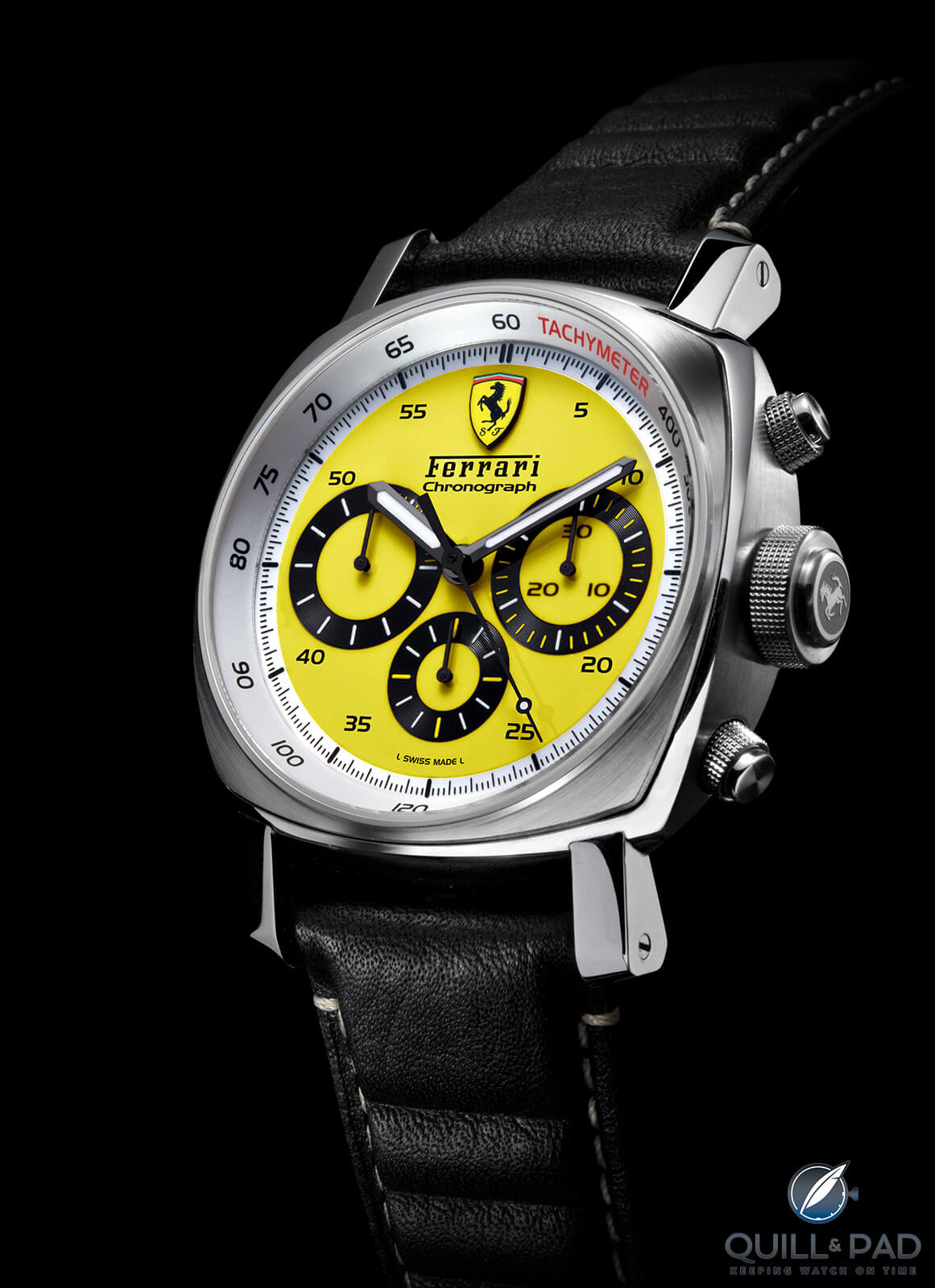
Ferrari Engineered by Panerai Scuderia Chronograph Reference FER00034
Paneristi and Ferraristi unite
When the Panerai/Ferrari collaboration was announced back in March 2006, I thought to myself, “These Italian brands share so much more than just a licensing agreement. They are also joined by history, tradition, quality, and above all passion.” For me, the idea of these two working on such a monumental project just fit.
The tifosi that stand at the edge of every racetrack graced by the Prancing Horse’s presence are also the ones who dream with their noses pressed against a windowpane of the city’s swankiest auto dealers. These are the same passionate lovers of Italian design who feel the way about their cars that Paneristi do about their watches. It seemed like a match made in heaven.
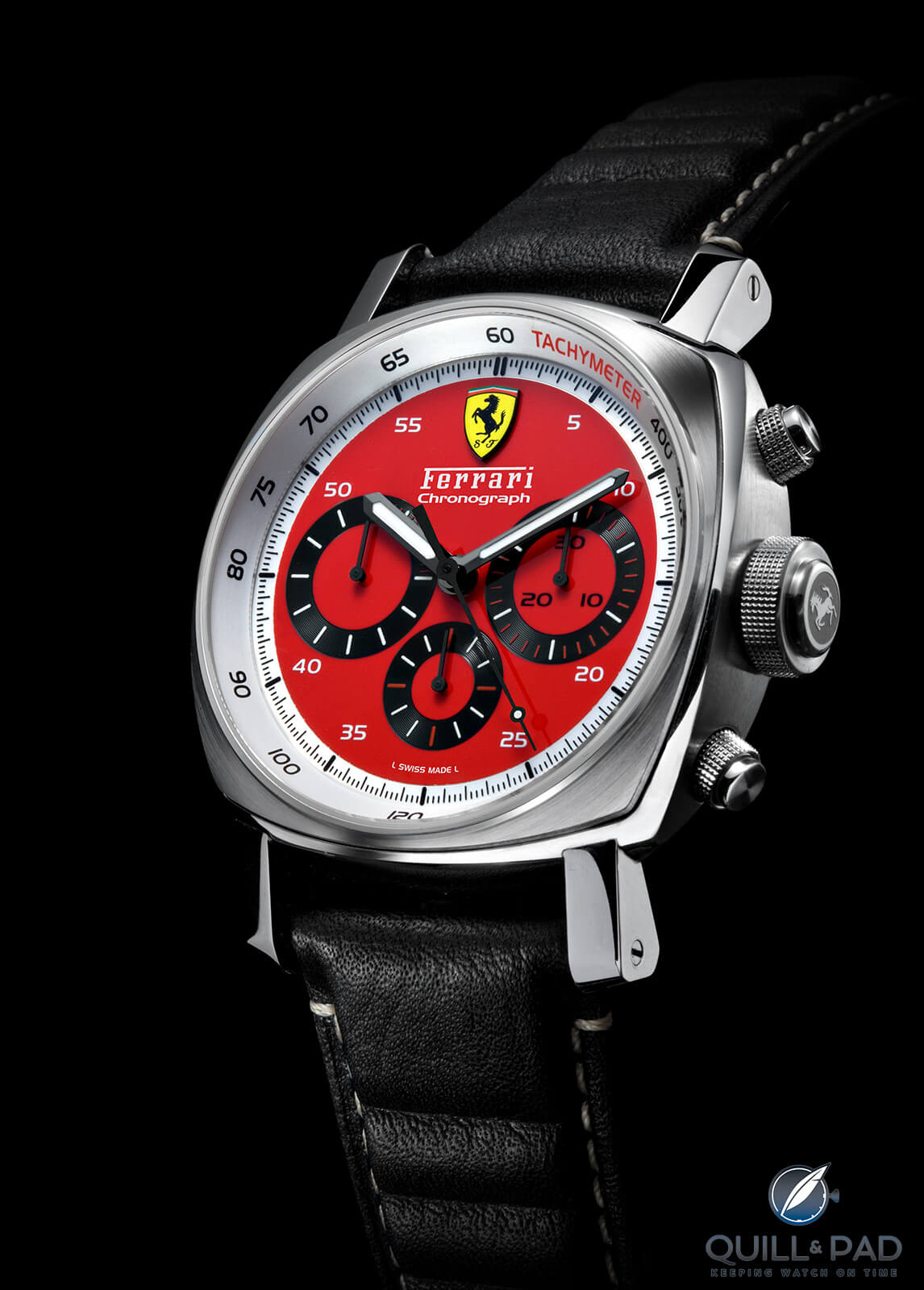
Ferrari Engineered by Panerai Scuderia Chronograph Reference FER00028
It is not just the massive size and build of the Panerai timepieces that have helped create such a following for the brand, it is also the precise look and feel of them: typically Italian, typically emotional.
And there is hardly another automobile brand in the entire world with a following like Ferrari. It seemed to me a foregone conclusion, then, that the two Italian icons should find their way to a partnership uniting the world’s Paneristi and Ferraristi.
Unfortunately, that was not to be.
How Panerai became the watch manufacturer of record for Ferrari
When then Panerai CEO Angelo Bonati heard that Girard-Perregaux had not renewed its license with Ferrari to make timepieces in 2005, he was immediately on the horn to his business partners and Richemont board members. A meeting with then Scuderia Ferrari director Jean Todt was imminent – and proved productive.
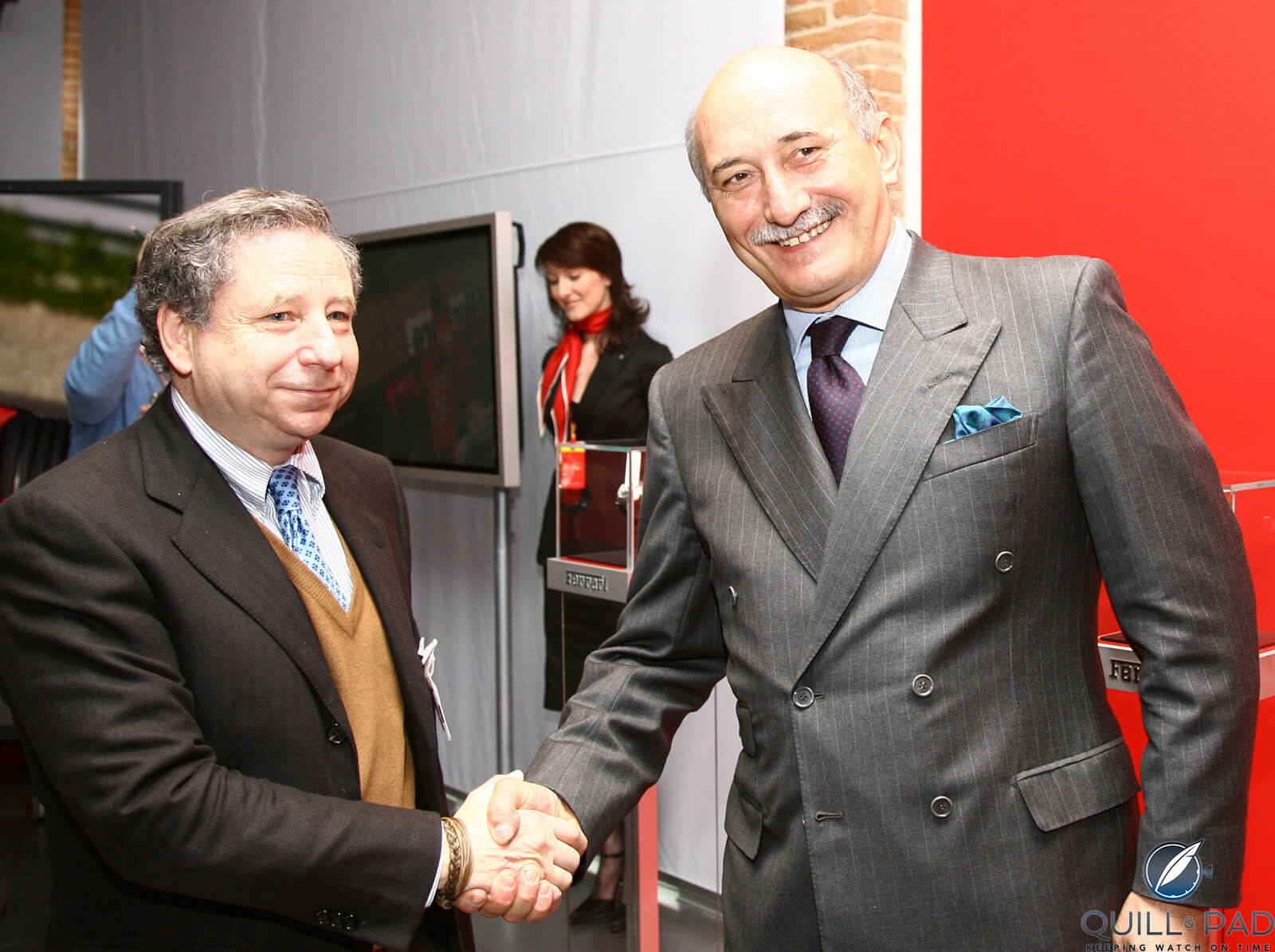
Jean Todt (Ferrari) and Angelo Bonati (Panerai) shake on their 2005-2010 partnership
“Cars and watches go hand in hand,” said Todt during the launch event in Maranello in March 2006, just prior to that year’s SIHH and the start of Formula 1 season. “This is an important moment in our company’s history.” The two marques came away with an instantaneous good feeling about their cooperation Bonati said to me in an interview at the time, and the ideas began to flow at Panerai.
“The maximum expression of sports timing is the chronograph,” Bonati continued. So it stood to reason that the collection would contain several versions of the stopwatch, debuting in steel in 2006, but with plans to be available in pink gold, titanium, and platinum later, with prices ranging between $5,000 and $50,000. If memory serves, the pink gold variations appeared, but I’m not entirely sure about the other two metals.
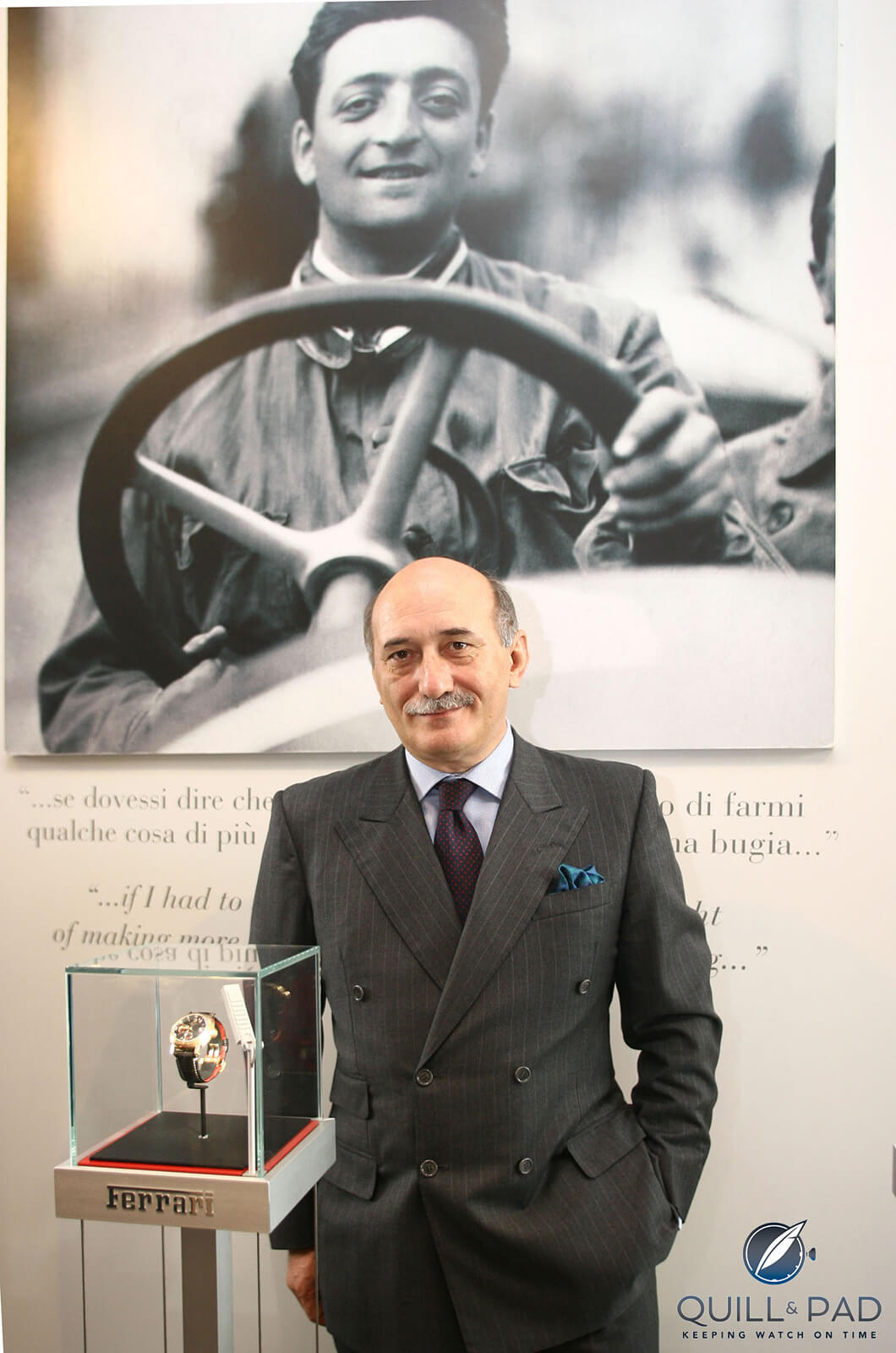
Angelo Bonati (Panerai) in front of a poster of Enzo Ferrari
“This collection represents a wedding with one of the most important brands in the world,” Bonati continued. “And ours has so much in common with Ferrari. We also work with technology, trying to produce the maximum in technology. In fact, my objective is to continue to move Panerai in the same direction.”
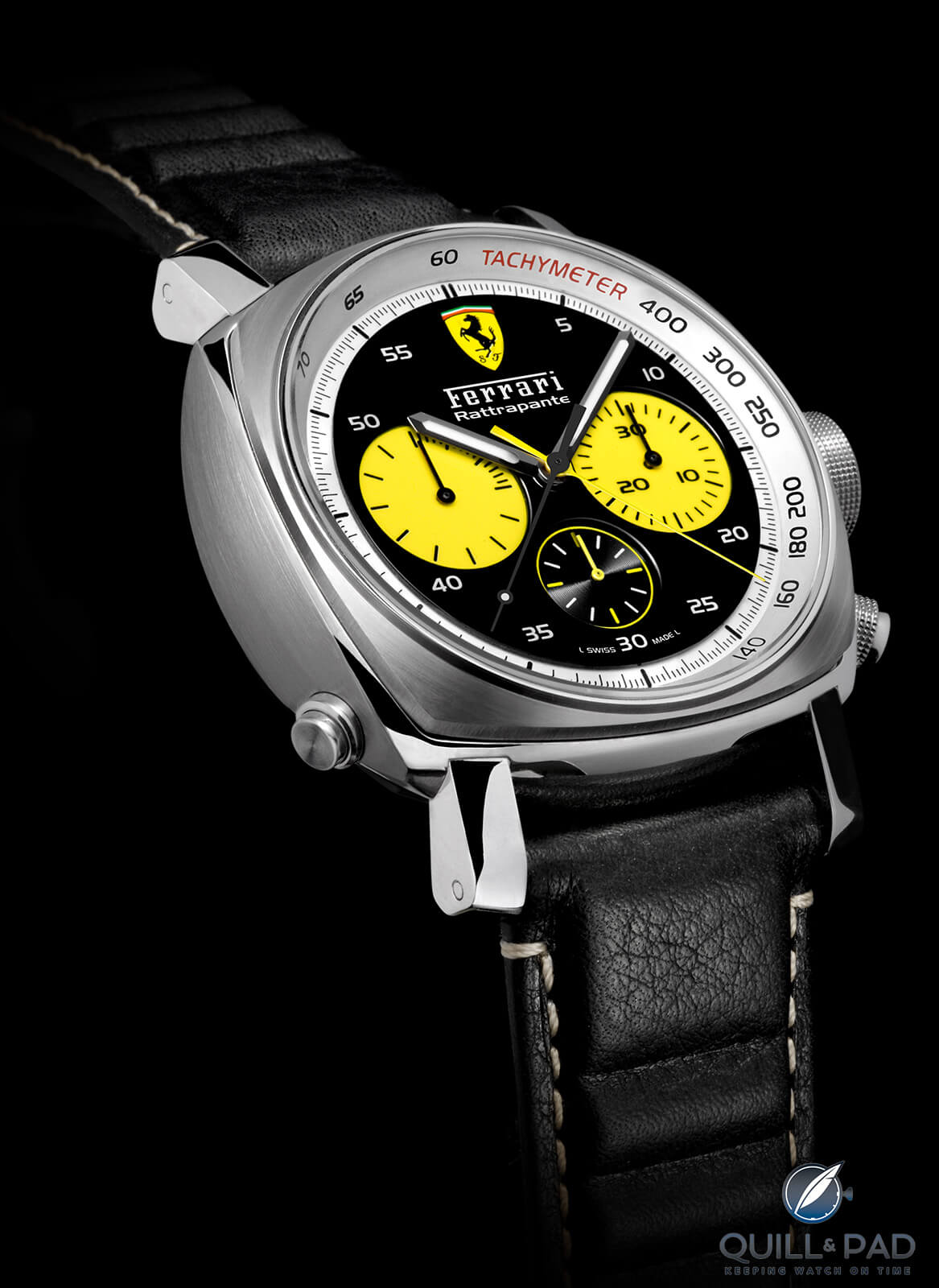
Ferrari Engineered by Panerai Scuderia Rattrapante Reference FER00026
Why Ferrari?
Why Ferrai? Bonati smiled when I asked this question. It seemed so obvious to him – and surely to others – but he patiently answered, and his reply was unexpected. “Panerai is always involved in the ‘sea.’ We wanted to branch out into ‘land’ as well. And Ferrari is the temple of high speed.
“Our goal is to produce a Panerai Ferrari watch, not a Panerai for Ferrari. This is not just a label, but a brand. This is not ‘made for,’ but ‘engineered by.’ It’s easy to just take something that you already have and change it. We did it differently. The risk in doing something like this is to make it banal. The greatness of Ferrari deserves more. Its history, present, and future all need to be depicted. We want to establish a new concept, not just a label.”
The contract between Ferrari and Panerai was for five years – and that is all it lasted, even though Bonati, who was looking to make a long-term investment in the new sub-brand, considered it a substantial amount of time at the outset. Like his work with Panerai, he was not looking for a flash in the pan. “We don’t consider this agreement a cash cow. It is an investment for the future,” he explained at the time.
“Ferrari is the best expression of Italian design, but the approval system we have set up only checks that Panerai is respecting the brand,” he added, making sure that it was understood that Panerai was fully in charge of creation, creativity, and distribution, though the Ferrari side was certainly active in the creativity factor. “We tried to extract Ferrari’s ‘DNA’ in order for the product to remain consistent.”
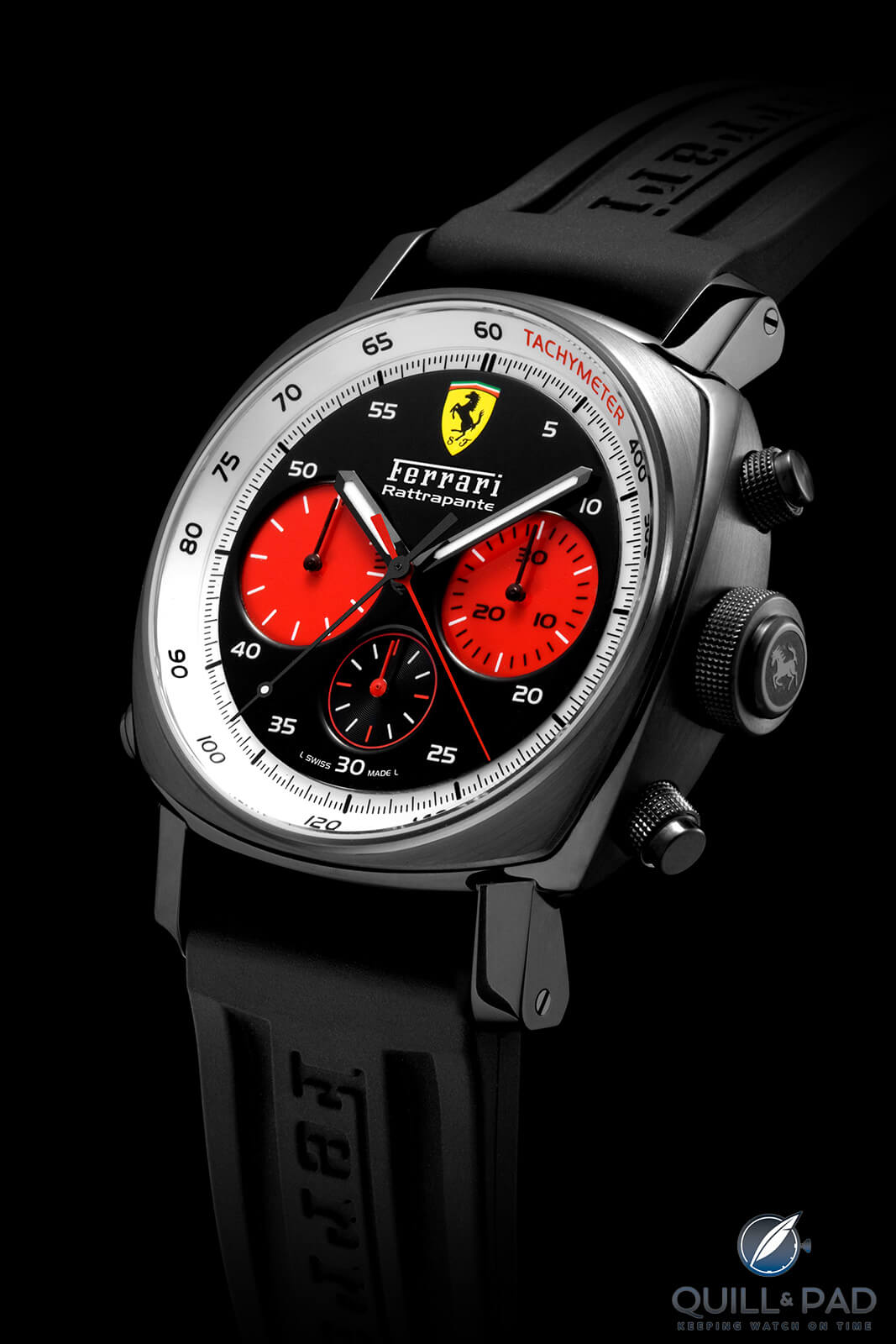
Ferrari Engineered by Panerai Scuderia Rattrapante and FER00033
Ferrari by Officine Panerai: Granturismo and Scuderia
The concept of Panerai’s Ferrari timepieces was not to simply take existing watches from the collection and add the famous Prancing Horse logo, something that had often been done in the past, but rather to create a new collection from scratch using the brand’s know-how to develop a collection with a distinct identity of its own.
Over a twelve-month period, sketches from Panerai’s young designers were presented, discussed, reworked, and finally accepted. A collection came to light that, although very obviously containing Panerai’s “DNA,” was different from what the company had previously issued.
The most striking element was perhaps the brushed and polished case, which was designed to resemble the aerodynamic sportscars yet still retain the characteristic Panerai look. The result was no accident for Panerai had six different technicians working on these cases. The case exuded a strong feeling, giving off an aura of speed and excitement but not one that would alienate existing Panerai clients.
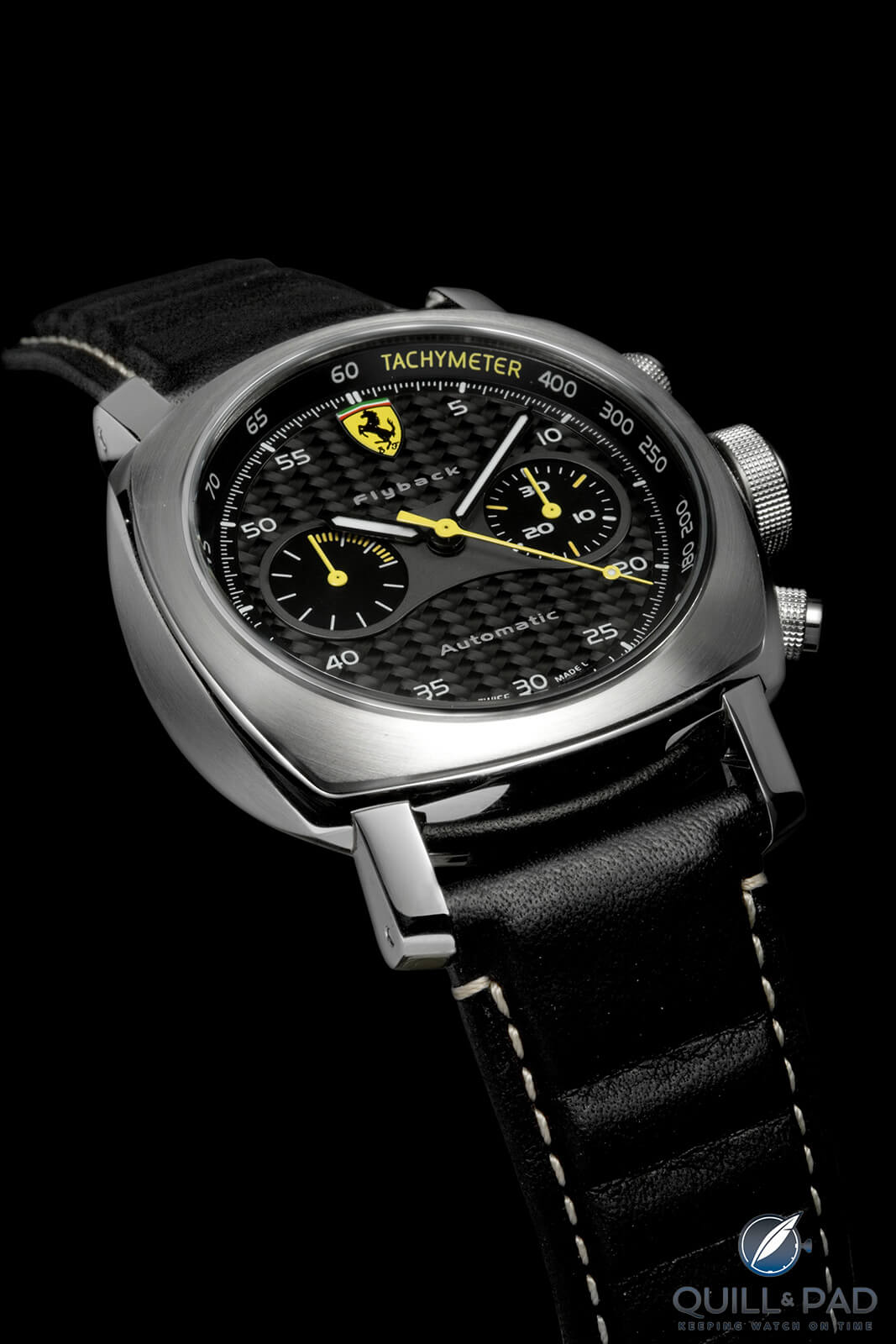
Ferrari Engineered by Panerai Scuderia Chronograph Reference FER00014
The premier collection comprised 11 references. The dials of the two main lines, Granturismo and Scuderia, were designed to match the appearance of dashboard elements found in the exclusive sportscars. From the black checkering of some of the dials’ carbon fiber structures to the titanium masks and frames surrounding some of the Scuderia chronograph totalizers, the dials embodied details of Ferrari styling.
Not to mention the magic logo of Ferrari making its way across the top of the black, yellow, and, later, red dials. The Scuderia models featured the Prancing Horse shield, while the Granturismo line showcased the Ferrari logo at 12 o’clock.
Then there were the chronograph buttons, the design of which was inspired by buttons found on a Ferrari’s dashboard.
This styling was continued on the screw-down case back of the watch as well. The Granturismo line featured a solid case back, protecting the “engine,” and embossed with a very large Prancing Horse and the words “engineered by Officine Panerai.”
The case back of the Scuderia line was fitted with a sapphire crystal window decorated with a metallic grid printed on the underside, exuding a protective feel. This case back’s bezel was also inscribed with “engineered by Officine Panerai.”
The straps, rubber or leather, and folding clasps were all new for these models. The buckle, looking like a car’s hood, was even patented in Panerai’s name.
Panerai for Ferrari movements
Every Panerai movement used in the Ferrari collection was an officially certified chronometer tested by the C.O.S.C. These movements from the existing Panerai collection of the time were not manufacture movements, but based on ETA ébauches: they ran the gamut from a simple three-handed watch (“solotempo”) to a GMT model – and later even a perpetual calendar – making sure to include the all-important chronograph and crowning the collection with a split-seconds chronograph for each of the two lines.
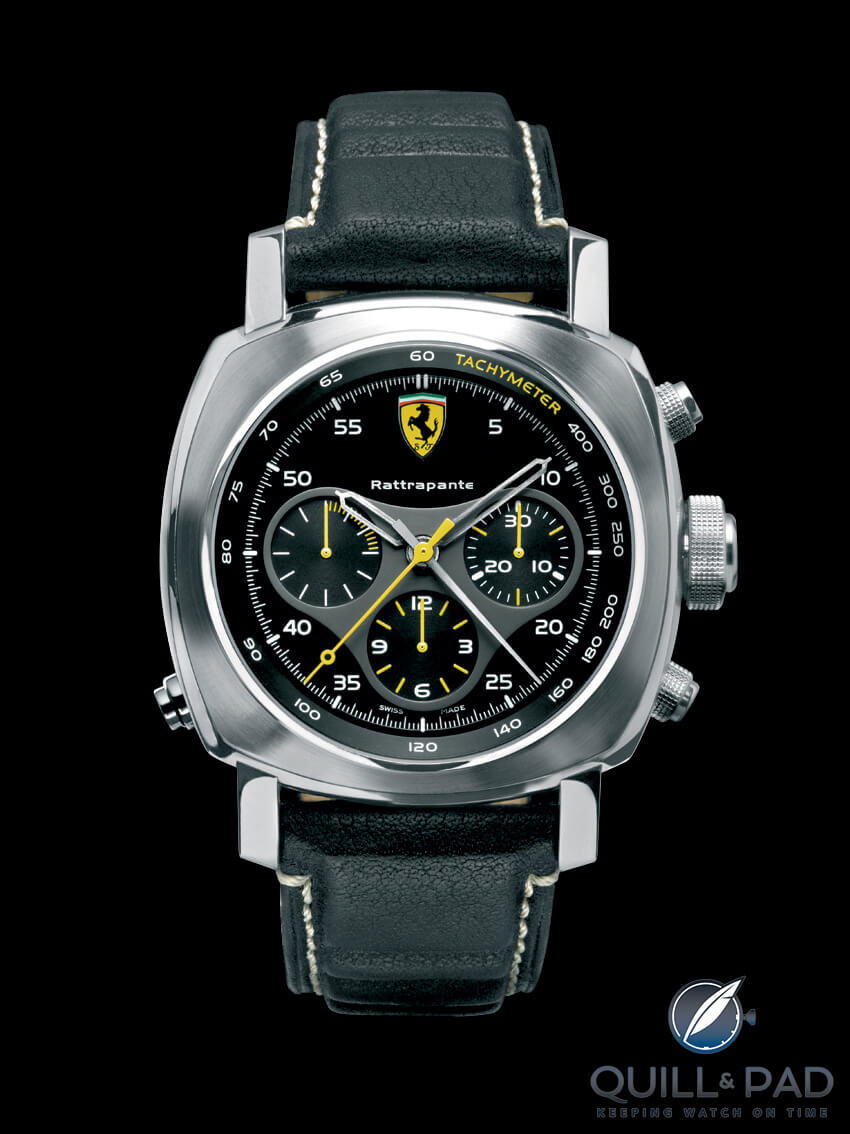
Ferrari Engineered by Panerai Scuderia Rattrapante Reference FER00010
These rattrapantes were at home in Officine Panerai Caliber OP XVIII, a movement that was created in conjunction with specialist La Joux-Perret based on the reliable Valjoux 7750. This movement contained 31 jewels, a glucydur balance, Incabloc shock protection, and was decorated with côtes de Genève and blued screws. This automatic movement with a power reserve of 42 hours featured a rotor engraved with the the Prancing Horse.
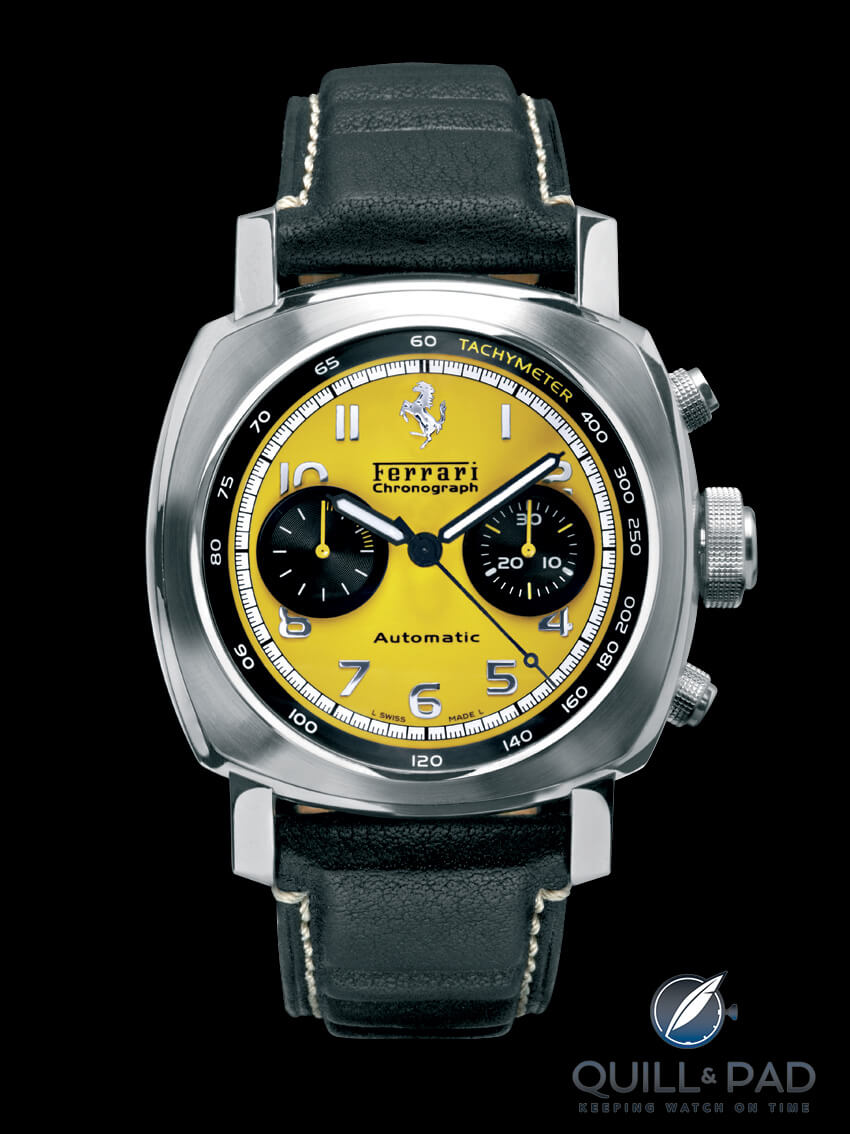
Ferrari Engineered by Panerai Scuderia Granturismo Chronograph Reference FER00011
The Granturismo chronograph, which initially featured a bright yellow dial indicative of the classic Ferrari color, was powered by Officine Panerai Caliber OP XII, also based on the ever-trusty Valjoux 7750. It had a power reserve of 46 hours and was just as decorated as its sibling, including the famed equestrian Ferrari logo on the rotor.
All these watches were water-resistant to 100 meters thanks in part to the screw-down case back and the screw-in crown, which could be simply locked in place with just a third of a turn.
The first eleven references were unveiled at the Ferrari factory in Maranello at a press event on March 23, 2006 and were officially presented to the public at SIHH 2006, which took place in April that year. They became available to buy through fine jewelers and Ferrari dealers in the summer of 2006.
Further additions to the collection followed through the end of 2009, including a 300-piece limited edition in honor of the then new Ferrari California car.
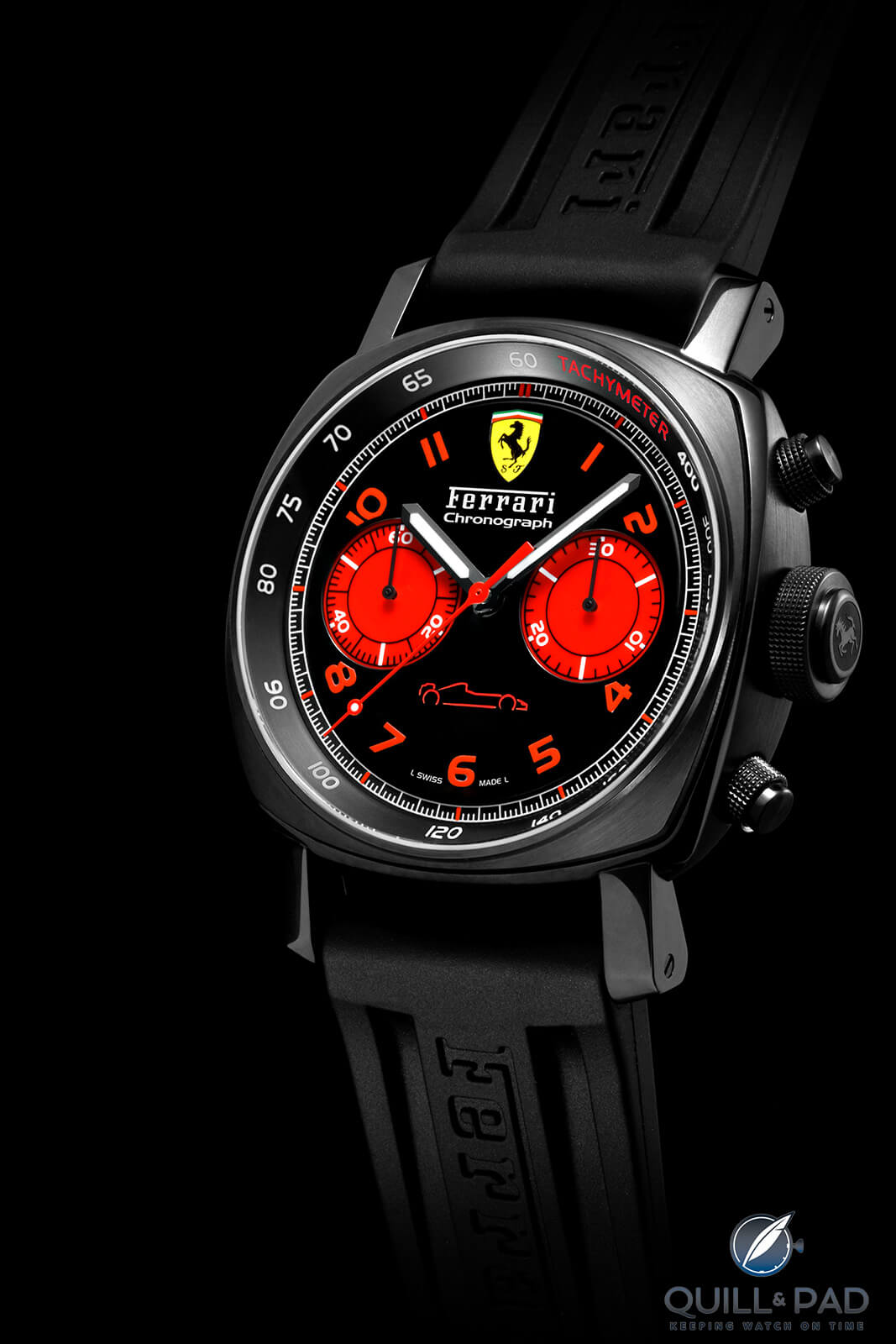
Ferrari Engineered by Panerai Scuderia Chronograph Reference FER00038
But by then the Ferraristis’ interest was lagging. To counter this, the new models became quite a bit more colorful. The showpiece was a chronograph with a DLC-coated stainless steel case, whose trendy-for-the-time dark appearance made the bright yellow and red applied numerals, hands, counters, and logos pop. A new generation of case design featured a narrower bezel and a correspondingly larger dial opening only partially filled with a wider flange housing a 60-minute scale.
But by the time the original contract had expired, so had the partnership – with Ferrari moving on to a nine-year deal with Hublot.
But that’s the subject of a whole new story. Stay tuned.
Quick Facts Ferrari Engineered by Panerai Granturismo Chronograph Reference FER00011
Case: 45 x 16.75 mm, stainless steel, crown with Ferrari logo, steel case back, water resistance 100 m
Movement: automatic Caliber OP XII (base ETA Valjoux 7750), 46-hour power reserve, 4 Hz/28,800 vph frequency, rotor engraved with Ferrari logo, officially certified C.O.S.C. chronometer
Functions: hours, minutes, seconds; chronograph
Limitation: 500 pieces
Year of manufacture: 2006
Retail price at introduction: €5,600 / $6,800
Quick Facts Ferrari Engineered by Panerai Scuderia Rattrapante Reference FER00010
Case: 45 x 16.85 mm, stainless steel, crown with Ferrari logo, water resistance 100 m
Movement: automatic Caliber OP XVIII (base ETA Valjoux 7750), 42-hour power reserve, 4 Hz/28,800 vph frequency, rotor engraved with Ferrari logo, officially certified C.O.S.C. chronometer
Functions: hours, minutes, seconds; split-seconds chronograph
Limitation: 500 pieces
Year of manufacture: 2006
Retail price at introduction: €9,200 / $11,200
Quick Facts Ferrari Engineered by Panerai Scuderia Flyback Chronograph Reference FER00014
Case: 45 x 16.85 mm, stainless steel, crown with Ferrari logo, water resistance 100 m
Dial: carbon fiber
Movement: automatic Caliber OP XIX (base ETA Valjoux 7750), 42-hour power reserve, 4 Hz/28,800 vph frequency, rotor engraved with Ferrari logo, officially certified C.O.S.C. chronometer
Functions: hours, minutes, seconds; flyback chronograph
Limitation: 500 pieces
Year of manufacture: 2007
Retail price at introduction: $10,300
Quick Facts Ferrari Engineered by Panerai Scuderia Chronograph Reference FER00038
Case: 45 x 16.75 mm, DLC-coated stainless steel, crown with Ferrari logo, steel case back, water resistance 100 m
Movement: automatic Caliber OP XII (base ETA Valjoux 7750), 46-hour power reserve, 4 Hz/28,800 vph frequency, rotor engraved with Ferrari logo, officially certified C.O.S.C. chronometer
Functions: hours, minutes, seconds; chronograph
Year of manufacture: 2009
Retail price at introduction: $12,600
Quick Facts Ferrari Engineered by Panerai Scuderia Chronograph Reference FER00034 (yellow) and FER00028 (red)
Case: 45 x 16.75 mm, stainless steel, crown with Ferrari logo, steel case back, water resistance 100 m
Movement: automatic Caliber OP XII (base ETA Valjoux 7750), 46-hour power reserve, 4 Hz/28,800 vph frequency, rotor engraved with Ferrari logo, officially certified C.O.S.C. chronometer
Functions: hours, minutes, seconds; chronograph, tachymeter scale
Year of manufacture: 2009
Quick Facts Ferrari Engineered by Panerai Scuderia Rattrapante Reference FER00026 (yellow) and FER00033 (red)
Case: 45 x 16.85 mm, stainless steel (black DLC coating Ref. FER00033), crown with Ferrari logo, water resistance 100 m
Movement: automatic Caliber OP XVIII (base ETA Valjoux 7750), 42-hour power reserve, 4 Hz/28,800 vph frequency, rotor engraved with Ferrari logo, officially certified C.O.S.C. chronometer
Functions: hours, minutes, seconds; split-seconds chronograph
Year of manufacture: 2009
*This article was first published on May 8, 2021 at History Of Ferrari Watches: Engineered by Officine Panerai.
You may also enjoy:
McLaren Formula 1 Team Announces New Sponsoring Partner Richard Mille Following TAG Heuer Departure
Sheaffer Partners With Prancing Horse To Create The Scuderia Ferrari Writing Collection
Leave a Reply
Want to join the discussion?Feel free to contribute!



No automotive brand has as fabled a past as Ferrari and no brand has made such disastrous choices of horological partners.
U.K. Commendatore was famed for firing drivers on a whim and the brand seems to do the same with its horological partners. Does anyone remember the relationship with Cartier in the 1970s? Yes they were badged Cartier, but they were Seiko 7A28s with a Cavallino Rampante on the dial. Of the three brands involved in this travesty, only Seiko could hold their head up high.
I have to be honest and say that I really liked the Girard Perregaux years and the long connection between the Macalusos and motor sport meant that the relationship had some grounding in reality – plus, they were all Italian, even if the watches were Swiss.
The following relationships between Ferrari and Panerai and then Hublot reminded me of nothing more than the arranged marriages between the offspring of of medieval monarchs. Nobody expected love or even fidelity – all that mattered was the product of the union – offspring in one case and money in the latter.
RM are famed for getting their sporting ambassadors to use their watches during strenuous sporting activities – Bubba Watson and Rafael Nadal spring to mind. So now that the two brands have collaborated on a watch bearing both their names, I wonder if Leclerc or Sainz will be wearing the new wafer watch during the French GP next weekend?
Nicely said , Panerai is lowly brand , they have done super shady things not just once but almost as a habit, its the sociopaths brand of choice at this point .
It’s almost a cultural imperative to be shady. Ferrari are the biggest cheats in F1 history, old man Ferrari used to mistreat his drivers almost for his own amusement and their racing heritage has hardly been one of constant success. Subtract those races won by nefarious means and the only thing that makes them stand out is insufferable and misplaced arrogance.
The watches above exhibit the same shocking narcissism, but the adolescent branding is quite ridiculous.
In short, buying into this is the sign of a weak mind.
My guess is that will happen soon, James. RM always has its ambassadors wear its watches, and no one is shy about having them wear the big pieces.
I feel sorry for the F1 presenters and drivers who are contractually obliged to promote Mr Thousand’s awful creations.
For all the criticism of the collaboration, the case designs are still wonderful (and better than, for example, Panerai’s 1940s line). They have a wonderful curve about them, and some of the dials are interesting too. Some definitely scream for attention way too much, sure, but some of the subtler ones are again quite attractive (if you were to buy one because you like sports watches or Ferrari). I just wish they had spent more time on the movements inside. None of the information provided at the time showed the actual movements, which was a bit of a red flag.
Of course The Stuttgart Elephant in the room is Porsche. Just as iconic, with far more integrity. Even their ancillary products are done right.
Even their tobacco pipes are brilliant! 😁
https://www.smokingpipes.com/pipes/estate/misc/moreinfo.cfm?Product_ID=139884